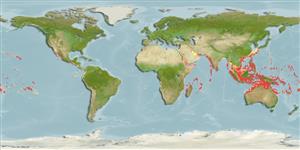Common names from other countries
Environment: milieu / climate zone / depth range / distribution range
Ecologia
marino associati a barriera corallina; distribuzione batimetrica 1 - 130 m (Ref. 37816), usually 1 - 20 m (Ref. 90102). Tropical; 32°N - 23°S
Indo-Pacific: Red Sea to the Marquesan and Mangaréva islands, north to southern Japan, south to New Zealand (Ref. 5755).
Size / Peso / Age
Maturity: Lm ? range ? - ? cm
Max length : 30.0 cm TL maschio/sesso non determinato; (Ref. 9710)
Spine dorsali (totale): 7; Raggi dorsali molli (totale): 13-14; Spine anali 2; Raggi anali molli: 9. Body dark brown with yellow stripes; small juveniles with spots, specimens up to 5 cm SL with 3 stripes, specimens at least 8 cm SL with 6 stripes, the number of stripes increases and may break into a series of dashes in large adults (Ref. 4326).
Inhabits coastal waters over corals and rocky substrates (Ref. 5213, 48635). Usually hides beneath ledges and small caves during the day (Ref. 4326, 48635). Small juveniles have only two white stripes, dividing with growth into numerous lines. The lines break-up into dashes and spots when adult (Ref. 48635). Feeds on fishes (Ref. 4821). Has toxin-producing glands in the dermis (Ref. 4326) which is extremely bitter to the taste (Ref. 11441). Minimum depth reported taken from Ref. 30874.
Life cycle and mating behavior
Maturità | Riproduzione | Deposizione | Uova | Fecundity | Larve
Randall, J.E., 1986. Grammistidae. p. 537-538. In M.M. Smith and P.C. Heemstra (eds.) Smiths' sea fishes. Springer-Verlag, Berlin. (Ref. 4326)
IUCN Red List Status (Ref. 130435)
CITES (Ref. 128078)
Not Evaluated
Threat to humans
Reports of ciguatera poisoning (Ref. 31637)
Human uses
Pesca: scarso interesse commerciale; Acquario: Commerciale
Informazioni ulteriori
Nomi ComuniSinonimiMetabolismoPredatoriEcotossicologiaRiproduzioneMaturitàDeposizioneFecundityUovaEgg development
BibliografiaAcquacolturaProfilo di acquacolturaVarietàGeneticaElectrophoresesEreditarietàMalattieElaborazioneMass conversion
Strumenti
Special reports
Download XML
Fonti Internet
Estimates based on models
Preferred temperature (Ref.
115969): 25.2 - 29, mean 27.9 (based on 1014 cells).
Phylogenetic diversity index (Ref.
82804): PD
50 = 1.0000 [Uniqueness, from 0.5 = low to 2.0 = high].
Bayesian length-weight: a=0.01148 (0.00451 - 0.02922), b=3.06 (2.84 - 3.28), in cm Total Length, based on LWR estimates for this (Sub)family-body shape (Ref.
93245).
Trophic level (Ref.
69278): 4.0 ±0.66 se; based on food items.
Fishing Vulnerability (Ref.
59153): Low vulnerability (20 of 100).
